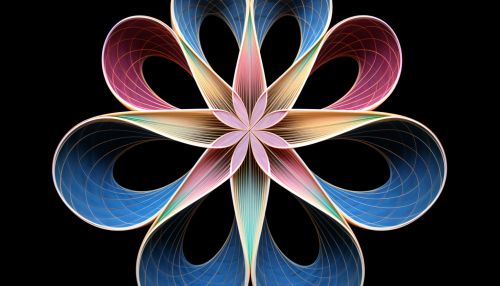Hyperbolic geometry
Introduction
Hyperbolic geometry is a non-Euclidean geometry, the parallel postulate of which differs from that of Euclidean geometry. The model of hyperbolic geometry was first formulated by the Hungarian mathematician János Bolyai and the Russian mathematician Nikolai Ivanovich Lobachevsky, independently of each other, in the early 19th century. This geometry has been of significant interest in the field of mathematics and has found applications in various areas such as topology, complex analysis, and theoretical physics.


Mathematical Foundations
Hyperbolic geometry is based on a set of axioms, or postulates, which are assumed to be true without proof. These axioms are similar to those of Euclidean geometry, with the exception of the parallel postulate. In hyperbolic geometry, the parallel postulate is replaced by the hyperbolic parallel postulate, which states that for any given line L and point P not on L, there exist at least two lines through P that do not intersect L. This is in contrast to Euclidean geometry, where there is exactly one parallel line through P that does not intersect L.
Models of Hyperbolic Geometry
There are several models of hyperbolic geometry that have been developed, each with its own unique properties and advantages. These include the Poincaré disk model, the Klein model, and the hyperboloid model.
Poincaré Disk Model
The Poincaré disk model is a model of hyperbolic geometry in which the hyperbolic plane is represented as the interior of a disk. The geodesics, or shortest paths between points, are represented by arcs of circles that intersect the boundary of the disk at right angles.
Klein Model
The Klein model, also known as the Beltrami-Klein model, is another model of hyperbolic geometry. In this model, the hyperbolic plane is represented as the interior of a disk, but the geodesics are represented by straight lines.
Hyperboloid Model
The hyperboloid model is a model of hyperbolic geometry in which the hyperbolic plane is represented as a hyperboloid in three-dimensional space. The geodesics are represented by intersections of the hyperboloid with planes through the origin.
Applications of Hyperbolic Geometry
Hyperbolic geometry has found applications in a number of different fields. These include, but are not limited to, topology, complex analysis, and theoretical physics.
Topology
In topology, hyperbolic geometry is used in the study of manifolds, particularly those of negative curvature. The concept of a hyperbolic manifold has been instrumental in the development of geometric topology.
Complex Analysis
In complex analysis, hyperbolic geometry is used in the study of Riemann surfaces and automorphic forms. The Poincaré disk model of hyperbolic geometry is particularly useful in this context.
Theoretical Physics
In theoretical physics, hyperbolic geometry plays a role in the study of special and general relativity. The hyperboloid model of hyperbolic geometry is used in the Minkowski space-time model of special relativity.
